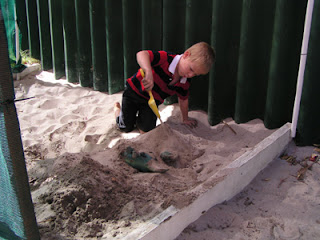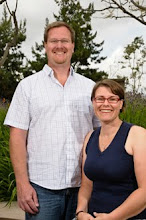For the last fortnight we have been reading about dinosaurs for science. We read much of Dinosaurs by Design and also read through an assortment of books on individual dinosaurs that we borrowed from the library. Our two favourite fiction books about dinosaurs are Harry and the Bucketful of Dinosaurs by Ian Whybrow, illus. Adrian Reynolds, which Joshua picked out at the bookstore on Saturday to spend his birthday gift voucher on (thanks Uncle Michael!) and Dinosaur Encore by Patricia Mullins, which we were given second hand from Jeff's cousins.
Of course, our time learning about dinosaurs wasn't all reading. This afternoon, Joshua had a lot of fun burying his plastic dinosaurs in a "swamp" in our sandpit, and then washing them off in the sink just like Harry with his Bucketful of Dinos. I think I overheard him saying something about burying them in mud like during Noah's flood... Below is Joshua's first oral report for Science. The only bits I've added are [in square brackets]. I did help him with some of the names but only giving hints (eg first two phonemes) - he had to be able to tell me the whole name himself. I did do a fair bit of prompting with questions. Remember, he's only just turned five!
Below is Joshua's first oral report for Science. The only bits I've added are [in square brackets]. I did help him with some of the names but only giving hints (eg first two phonemes) - he had to be able to tell me the whole name himself. I did do a fair bit of prompting with questions. Remember, he's only just turned five!
Dinosaurs are reptiles. Well, dinosaurs can squash you even if you are trying to be careful so just make sure you are careful. [Some] dinosaurs are predators like meat-eating Rex, the king of dinosaurs. Brains of dinosaurs can be big or small. Some can be clever and some can be not clever, like some can run and some can not run, some can run fast and some can run slow. Most dinosaurs are predators and they are extinct.
The first dinosaur fossil that was found was the tooth of an Iguanodon. It was found [in 1822] in England by a lady called Mary who was married to a doctor [Dr Gideon Mantell], who liked finding fossils. Sometimes fossils are of bones and some fossils are found in jumbled heaps like they were tossed around. [In 1840 Sir Richard Owen] thought the fossilised animals should have a new name and he called them “Dinosaurs” which means “terrible lizards”. [In 1877] some miners in a coal mine in Belgium in Europe found fossilised Iguanodon bones. They found lots of Iguanodon bones, of more than 30 Iguanodons.
Some dinosaurs have horns. Some of these are called Triceratops and Styracosaurus.
Some dinosaurs have plates on their tails and backs, and some have spikes on the end of their tails to smash meat-eating dinosaurs. Some of these are called Stegosaurus, Kentrosaurus and Tuojiangosaurus, which was found in China.
Some dinosaurs have armour. Some of them are called Ankylosaurus and Polacanthus. Ankylosaurs have a club on their tail and they have spikes all over their back and what’s under the spikes is thick skin like armour. They smash predators with their tail.
The duck-billed dinosaurs include Edmontosaurus and Parasaurolophus. Their fossils were found in North America.
Tyrannosaurus rex stood on two legs.
The biggest dinosaur was Seismosaurus. Long dinosaurs included Diplodocus, Apatosaurus [also sometimes called Brontosaurus by mistake] and Brachiosaurus, which was tall.
Pterodactyls were flying dinosaurs. They flew up in the sky and you couldn’t catch them because they were so fast and high. Scientists used to think they jumped off cliffs, but they could fly like birds. A big flying dinosaur from North America was the Quetzalcoatlus, which was very big.
Well, I think you’ve learnt enough now.
Monday, 18 February 2008
Dinosaurs
Labels:
homeschooling,
science
Subscribe to:
Post Comments (Atom)









No comments:
Post a Comment